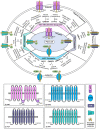Plant Secondary Metabolite Transporters: Diversity, Functionality, and Their Modulation
- PMID: 34777438
- PMCID: PMC8580416
- DOI: 10.3389/fpls.2021.758202
Plant Secondary Metabolite Transporters: Diversity, Functionality, and Their Modulation
Abstract
Secondary metabolites (SMs) play crucial roles in the vital functioning of plants such as growth, development, defense, and survival via their transportation and accumulation at the required site. However, unlike primary metabolites, the transport mechanisms of SMs are not yet well explored. There exists a huge gap between the abundant presence of SM transporters, their identification, and functional characterization. A better understanding of plant SM transporters will surely be a step forward to fulfill the steeply increasing demand for bioactive compounds for the formulation of herbal medicines. Thus, the engineering of transporters by modulating their expression is emerging as the most viable option to achieve the long-term goal of systemic metabolic engineering for enhanced metabolite production at minimum cost. In this review article, we are updating the understanding of recent advancements in the field of plant SM transporters, particularly those discovered in the past two decades. Herein, we provide notable insights about various types of fully or partially characterized transporters from the ABC, MATE, PUP, and NPF families including their diverse functionalities, structural information, potential approaches for their identification and characterization, several regulatory parameters, and their modulation. A novel perspective to the concept of "Transporter Engineering" has also been unveiled by highlighting its potential applications particularly in plant stress (biotic and abiotic) tolerance, SM accumulation, and removal of anti-nutritional compounds, which will be of great value for the crop improvement program. The present study creates a roadmap for easy identification and a better understanding of various transporters, which can be utilized as suitable targets for transporter engineering in future research.
Keywords: ABC; MATE; NPF; PUP; metabolite transporter; secondary metabolite; systemic metabolic engineering; transporter engineering.
Copyright © 2021 Nogia and Pati.
Conflict of interest statement
The authors declare that the research was conducted in the absence of any commercial or financial relationships that could be construed as a potential conflict of interest.
Figures




Similar articles
-
Membrane transporters: the key drivers of transport of secondary metabolites in plants.Plant Cell Rep. 2021 Jan;40(1):1-18. doi: 10.1007/s00299-020-02599-9. Epub 2020 Sep 21. Plant Cell Rep. 2021. PMID: 32959124 Review.
-
The emerging field of transport engineering of plant specialized metabolites.Curr Opin Biotechnol. 2013 Apr;24(2):263-70. doi: 10.1016/j.copbio.2012.09.006. Epub 2012 Oct 4. Curr Opin Biotechnol. 2013. PMID: 23040969 Review.
-
Enhancement of Plant Productivity in the Post-Genomics Era.Curr Genomics. 2016 Aug;17(4):295-6. doi: 10.2174/138920291704160607182507. Curr Genomics. 2016. PMID: 27499678 Free PMC article.
-
Translational Metabolomics of Head Injury: Exploring Dysfunctional Cerebral Metabolism with Ex Vivo NMR Spectroscopy-Based Metabolite Quantification.In: Kobeissy FH, editor. Brain Neurotrauma: Molecular, Neuropsychological, and Rehabilitation Aspects. Boca Raton (FL): CRC Press/Taylor & Francis; 2015. Chapter 25. In: Kobeissy FH, editor. Brain Neurotrauma: Molecular, Neuropsychological, and Rehabilitation Aspects. Boca Raton (FL): CRC Press/Taylor & Francis; 2015. Chapter 25. PMID: 26269925 Free Books & Documents. Review.
-
[Progress of studies on ATP-binding cassette transporters and transportation of secondary metabolites in medicinal plants].Zhongguo Zhong Yao Za Zhi. 2021 Jan;46(1):52-56. doi: 10.19540/j.cnki.cjcmm.20200930.602. Zhongguo Zhong Yao Za Zhi. 2021. PMID: 33645051 Review. Chinese.
Cited by
-
A Molecular Toolbox to Identify and Quantify Grape Varieties: On the Trace of "Glera".Foods. 2023 Aug 17;12(16):3091. doi: 10.3390/foods12163091. Foods. 2023. PMID: 37628090 Free PMC article.
-
Multiomics comparison among populations of three plant sources of Amomi Fructus.Hortic Res. 2023 Aug 1;10(8):uhad128. doi: 10.1093/hr/uhad128. eCollection 2023 Aug. Hortic Res. 2023. PMID: 37560015 Free PMC article.
-
Characterization of Triterpene Saponin Glycyrrhizin Transport by Glycyrrhiza glabra.Plants (Basel). 2022 May 5;11(9):1250. doi: 10.3390/plants11091250. Plants (Basel). 2022. PMID: 35567251 Free PMC article.
-
Strategies, Achievements, and Potential Challenges of Plant and Microbial Chassis in the Biosynthesis of Plant Secondary Metabolites.Molecules. 2024 May 2;29(9):2106. doi: 10.3390/molecules29092106. Molecules. 2024. PMID: 38731602 Free PMC article. Review.
-
Genome-Wide Analysis of Multidrug and Toxic Compound Extruction Transporters in Grape.Front Plant Sci. 2022 Jul 14;13:892638. doi: 10.3389/fpls.2022.892638. eCollection 2022. Front Plant Sci. 2022. PMID: 35909729 Free PMC article.
References
-
- Bailly A. (2014). “Structure–function of plant ABC-transporters,” in Plant ABC Transporters, ed. Geisler M. (Switzerland: Springer International Publishing; ), 219–240. 10.1007/978-3-319-06511-3_12 - DOI
Publication types
LinkOut - more resources
Full Text Sources
Miscellaneous

